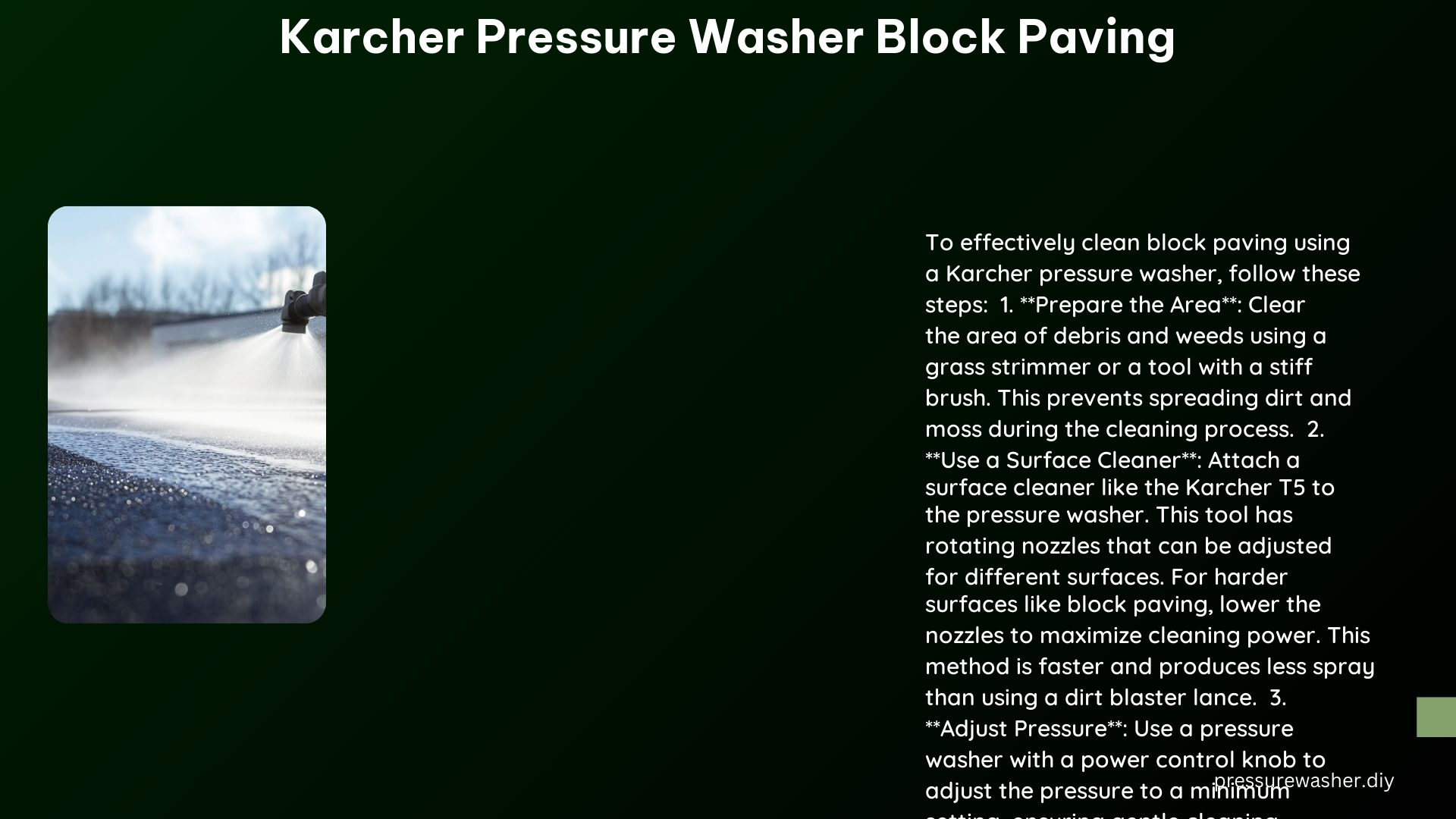Cleaning block paving with a Karcher pressure washer can be a highly effective way to restore the appearance and longevity of your outdoor surfaces. This comprehensive guide will provide you with the key attachments, pressure settings, and technical specifications to ensure a thorough and damage-free cleaning process.
Key Attachments Needed for Effective Cleaning
-
Surface Cleaner: The Karcher T5 Surface Cleaner is an essential attachment for cleaning large areas of block paving. This 12-inch wide cleaner features two high-pressure nozzles that rotate at 1,500 RPM, providing a splash-free and efficient cleaning experience. The T5 can remove dirt, moss, and grime from the surface of the pavers, leaving them looking refreshed and rejuvenated.
-
Dirt Blaster Lance: The Karcher Dirt Blaster Lance is a specialized attachment designed to tackle stubborn dirt and debris trapped in the gaps between pavers. This lance utilizes a high-pressure, rotating nozzle that can penetrate deep into the crevices, dislodging even the most stubborn contaminants. When used in conjunction with the surface cleaner, the dirt blaster lance ensures a comprehensive and thorough cleaning of the entire block paving area.
-
Power Scrubber: For cleaning stairs, edges, and other hard-to-reach areas, the Karcher Power Scrubber attachment is an invaluable tool. This attachment features a rotating brush head that can effectively scrub and clean these challenging surfaces, ensuring that no area is left untreated.
Adjusting Pressure Settings
-
Adjust the Pressure: The pressure setting on your Karcher pressure washer should be adjusted based on the type of pavers being cleaned. For natural stone pavers, such as granite or basalt, you can use a higher pressure setting, typically between 1,800 and 2,200 PSI (124 to 152 bar). However, for concrete or terracotta pavers, a lower pressure setting, ranging from 1,200 to 1,600 PSI (83 to 110 bar), is recommended to avoid potential damage to the surface.
-
Use the Right Nozzle: The rotating nozzle on the spray gun should be adjusted to the correct distance from the surface to ensure effective cleaning without causing any harm to the pavers. As a general guideline, the nozzle should be held approximately 6 to 12 inches (15 to 30 cm) away from the surface for optimal cleaning performance.
Benefits of Surface Cleaner vs. Dirt Blaster Lance
-
Speed: The Karcher T5 Surface Cleaner is significantly faster to use than the dirt blaster lance, making it the ideal choice for cleaning large areas of block paving. The surface cleaner can cover up to 290 square feet (27 square meters) per minute, allowing for rapid and efficient cleaning.
-
Cleanliness: The surface cleaner produces less spray and mist compared to the dirt blaster lance, resulting in a cleaner working environment and reduced risk of water damage to surrounding areas.
-
Effectiveness: While the dirt blaster lance is more effective at removing stubborn dirt and moss from the gaps between pavers, the surface cleaner provides a more comprehensive and uniform cleaning of the entire surface. For the best results, it is recommended to use both attachments in tandem, with the dirt blaster lance targeting the gaps and the surface cleaner addressing the broader paved area.
Technical Specifications
-
Karcher K5 Electric Pressure Washer: This model offers a powerful cleaning performance with a maximum pressure of 2,000 PSI (138 bar) and a water flow rate of 1.4 GPM (5.3 L/min). The K5 is an excellent choice for cleaning block paving, providing the necessary power and versatility to handle a wide range of cleaning tasks.
-
Karcher K4 Power Control Pressure Washer: Another suitable model for block paving cleaning, the K4 Power Control offers a maximum pressure of 1,900 PSI (131 bar) and a water flow rate of 1.3 GPM (5 L/min). This model comes equipped with the T5 surface cleaner and dirt blaster lance, making it a comprehensive solution for block paving maintenance.
-
Karcher T5 Surface Cleaner: Designed for large-area cleaning, the T5 surface cleaner has a cleaning width of 12 inches (30 cm) and can be used with various Karcher pressure washer models. Its dual high-pressure nozzles and rotating design ensure efficient and splash-free cleaning of block paving surfaces.
Additional Tips
-
Preparation: Before using a Karcher pressure washer, it is essential to remove any weeds, debris, or loose material from the joints between the pavers. This will ensure that the cleaning process is as effective as possible and that the pressure washer can reach all the necessary areas.
-
Safety: When operating a Karcher pressure washer, it is crucial to wear appropriate personal protective equipment, such as safety goggles, gloves, and sturdy footwear. Additionally, ensure that the work area is well-ventilated to prevent any potential health hazards.
-
Post-Cleaning: After completing the pressure washing process, it is recommended to sweep or blow away any remaining debris from the block paving surface. Applying a layer of kiln-dried sand to the joints can help maintain the pavers’ appearance and prevent future weed growth.
Reference Links
- Karcher Patio Cleaning Tips
- Karcher Guide to Cleaning Pavers
- Karcher Pressure Washer Block Paving Cleaning Video
By following the guidelines and technical specifications outlined in this comprehensive guide, you can effectively clean your block paving using a Karcher pressure washer, ensuring a long-lasting and visually appealing outdoor surface.

